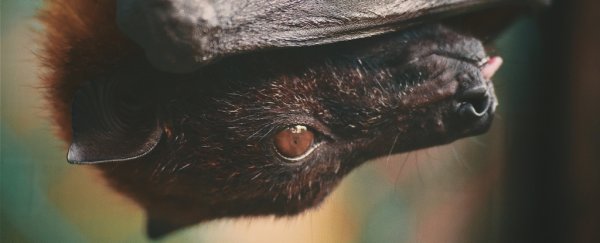Ebola. SARS. Rabies. MERS. Most probably even the flourishing new coronavirus, COVID-19. There's one animal that innocently and unwittingly gifts all these virulent scourges to humanity. Bats.
Why is that? According to new research, it's because bats may be the ultimate incubator, courtesy of a fiercely effective and robust immune system that seems to, in effect, train up viral strains, encouraging them to adapt and evolve into becoming as fit and infectious as they possibly can.
It's an unfortunate side effect of what is otherwise an awesome survival mechanism. Not unfortunate for bats, that is, but certainly for other species – because when viruses manage to leap from bats to other sorts of animals, including humans, the recipients' immune responses aren't equipped to counter these attuned, efficient, and highly transmissible pathogens.
"The bottom line is that bats are potentially special when it comes to hosting viruses," says disease ecologist Mike Boots from UC Berkeley.
"It is not random that a lot of these viruses are coming from bats."
In a new study, Boots and fellow researchers investigated virus infectivity on bat cell lines, including cultures from the Egyptian fruit bat (Rousettus aegyptiacus) and the Australian black flying fox (Pteropus alecto).
Cells called Vero cells from a monkey (the African green monkey, Chlorocebus), were also used as a control, but these monkey cells were at a definite disadvantage.
That's because one of the molecular mechanisms in bats' immune systems is the lightning fast production of a signalling molecule called interferon-alpha, which is triggered in the response of viruses. When interferon proteins are secreted by virus-infected cells, nearby cells go into a defensive, antiviral state.
The African green monkey cell line does not possess such advantages. In experiments, when the cell cultures were exposed to viruses mimicking Ebola and Marburg virus, the monkey cells were quickly overwhelmed. The bat cells, on the other hand, resisted the viral onslaught, thanks to their rapid interferon signalling.
The paradox, though, is that interferon ultimately seems to benefit viruses, even while it hinders their capacity to kill cells. While the signalling system prevents cells from dying, the infection nonetheless holds on, and the virus starts to adapt to the defensive regime, at least according to the team's computer simulations.
"This suggests that having a really robust interferon system would help these viruses persist within the host," says biologist and first author of the study, Cara Brook.
"When you have a higher immune response, you get these cells that are protected from infection, so the virus can actually ramp up its replication rate without causing damage to its host. But when it spills over into something like a human, we don't have those same sorts of antiviral mechanism, and we could experience a lot of pathology."
It's important to note that humans do have interferon-alpha, but bats seem to have a much easier time with viruses than we do.
Even when bats are infected with pathogens that can kill humans, they don't demonstrate obvious disease symptoms, but instead carry viruses as long-term persistent infections. That persistence, the researchers say, seems to be encouraged by interferon.
More research is needed to investigate why bat interferon systems seem to be more robust and faster than ours.
"Critically, we found that bat cell lines demonstrated a signature of enhanced interferon-mediated immune response … which allowed for establishment of rapid within-host, cell-to-cell virus transmission rates," the authors explain in their study.
"The antiviral state induced by the interferon pathway protects live cells from mortality in tissue culture, resulting in in vitro epidemics of extended duration that enhance that probability of establishing a long-term persistent infection."
The upshot, the team says, is that rapidly replicating viruses that have evolved within bats will probably cause enhanced virulence if they jump to subsequent hosts, including humans, with immune systems that diverge from those unique to bats.
Sometimes an intermediary is involved, like pigs, camels, or horses. Whichever animal is unlucky enough to be a spillover host, though, it's unlikely they'll be ready for the fate that awaits them.
Nonetheless, knowing how and why this happens is vital to fighting these viruses, no matter how formidable their training, gleaned inside the invulnerable bodies of bats, may have made them.
"It is really important to understand the trajectory of an infection in order to be able to predict emergence and spread and transmission," Brook says.
The findings are reported in eLife.
